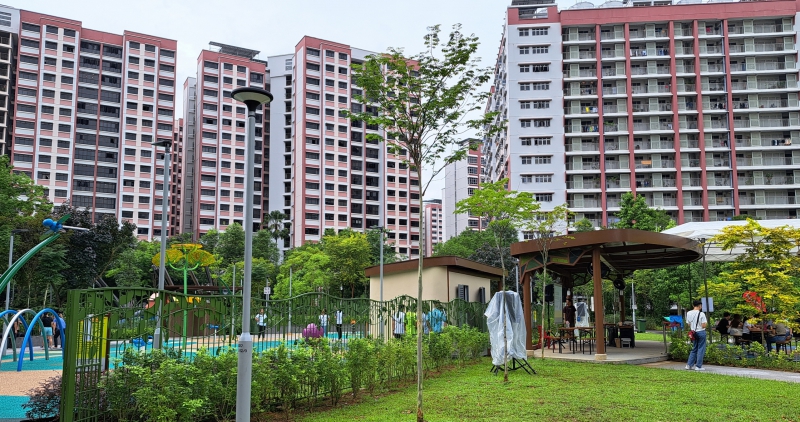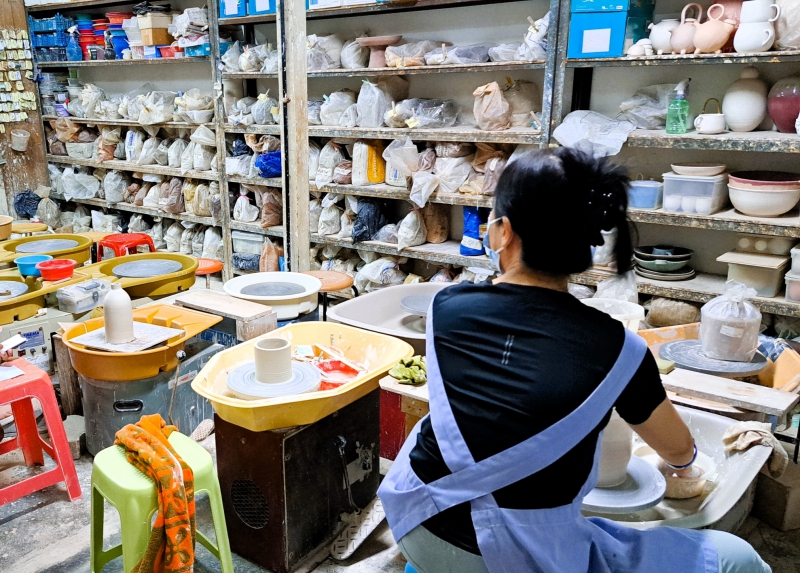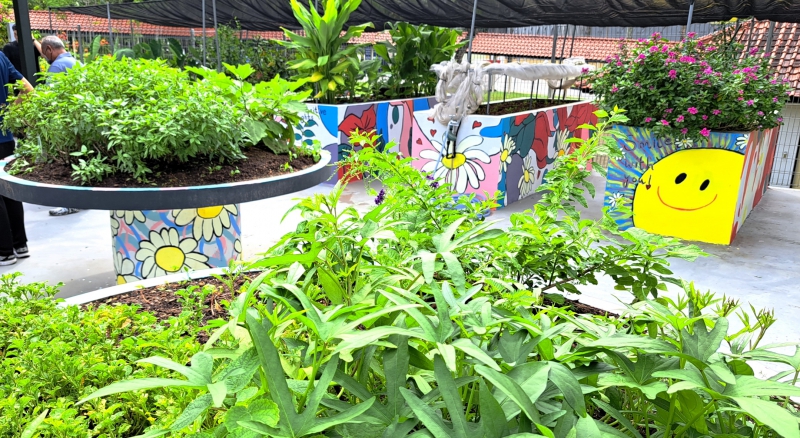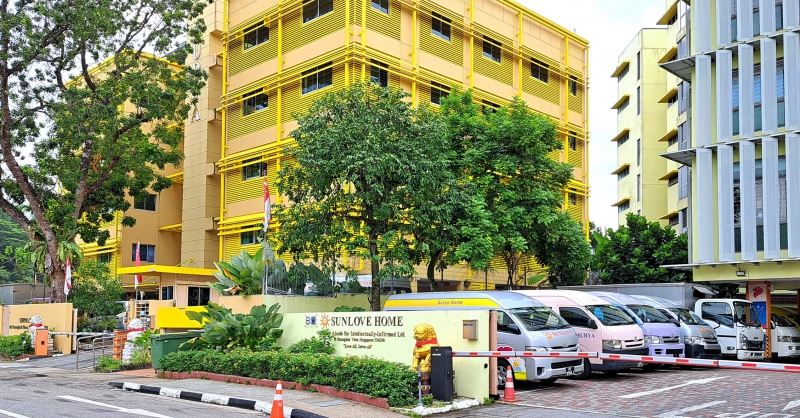万国的侠骨仁心:让特需群体实现生命价值
文图 · 李国樑

万国广场公园与周边的组屋
万国(Buangkok)是个21世纪冒起的组屋区,属于后港5万多个组屋单位的一部分。本世纪初,万国的村落被清除,如今已出现30多座组屋和一些私人住宅。仍在发展中的组屋区以万国弯、万国青、万国通道(Crescent,Green,Drive)为界,周边与杨厝港、后港和盛港为邻。
-800x398.jpg)
万国地形图(根据2025年谷歌地图绘制)
新组屋区的特色是年轻夫妇多,年幼孩童也多。位于万国组屋区心脏地带的万国广场(Buangkok Square Mall)和侧邻的万国广场公园(Buangkok Square Park),成为居民逛街休闲的好去处。由于好些居民更靠近盛港中(Sengkang Central),喜欢到盛港的商场活动,因此开阔通风的万国广场空间,常通过主办文化活动来注入人气。
“白象”让万国走红
隶属东北线的万国地铁站坐落在盛港中,可见万国与盛港密不可分。即便是最近启用的万国民众俱乐部,亦设于地铁站旁的盛港汇购物中心(Sengkang Grand Mall)内,慈爱回教堂(Masjid Al-Mawaddah)也由万国和盛港居民共用。
万国地铁站曾经出现过几头“白象”。原来地铁站早于2003年落成,但因达不到当局的基本营收要求而没开放,引起居民强烈不满。2005年国庆日之后部长到区内探访,居民在万国地铁站前竖起纸板白象表示抗议,万国于一夜间爆红。
万国地铁站终于在几个月后开放,通行第一个月的日均乘客量只有900人次,收入远远无法抵消成本。公众则认为公交运作应该整体惠民,而不是如此斤斤计较。反正公说公有理,婆说婆有理,对公交缺乏共识。随着地铁站周围新组屋一批批地落成,“白象”成为陈年往事。
“卷起纱笼”的甘榜罗弄万国
榜鹅河畔保留一小段昔日的罗弄万国公路(Lorong Buangkok),以及甘榜罗弄万国(Kampong Lorong Buangkok)这个本岛最后的乡村。
70年前建立起来的甘榜罗弄万国属于“新”甘榜,从最初的五、六户家庭发展到全盛时期的40多户人家。甘榜生活最叫人怀念的是守望相助的精神,村里的回教徒祷告室,就是由各族村民出钱出力兴建的。

甘榜罗弄万国有个别名“Kampong Selak Kain”,意思是将纱笼卷起来
甘榜罗弄万国有个别名“Kampong Selak Kain”,意思是将纱笼卷起来,指的是这里地势低,洪水侵袭时经常淹水,必须把长裙拉高涉水而过。20年前发生特别严重的水灾,志愿者在流经甘榜的溪流边筑起围栏作为权宜之计。至于甘榜的去留,留待他日发展实里达新镇时再另行计议。
万国以农业起家
新加坡联合树胶园(Singapore United Rubber Plantations Limited)是包括现在的万国组屋区在内的大地主,与已故富商李光前和家族掌控的万国公司(Bukit Sembawang)合并后,成为万国集团的子公司。百年前潮州劳工在这里的橡胶与烟草园工作,把坐拥东部至北部半壁江山的万国公司称为“Buangkok”,因此得名。
说到种植园,开埠以来,农业经历过风光岁月,有出口的经济作物如甘蜜、胡椒、黄梨和橡胶,也有自给自足的瓜果蔬菜。独立初期,尚有一成人口以传统农场为生,当局成立原产局为全岛农民提供培训援助,并就生产方法、动物营养和疾病控制等进行研发。随着城市化发展,如今农场仅占土地面积的百分之一, 多数食物从海外进口。
实里达山的“龙窑”陶瓷工作室
随着种植业走下坡,万国公司进军地产业,在种植园土地上兴建民宅。50年代三巴旺山住宅区(Sembawang Hills Estate)卖得红火,万国公司打铁趁热,依照相同模式发展实里达山(Seletar Hills Estate),主要买家是来自实里达空军基地的英国与澳大利亚驻军家庭。

三美光陶艺源自本地最早的龙窑“三美光缶窑”
实里达山很多原建筑都已改头换面,只有“山前”的一列店屋保留昔日痕迹,其中一间店铺由三美光陶艺用做工作室。三美光陶艺源自“三美光缶窑”,二战时期,创办人蔡应绍将位于惹兰缶窑(Jalan Hwi Yoh)25米长的蛇窑改建成50米的龙窑。战后制造的水缸,多数运到婆罗洲坤甸。经常在媒体出现的建国总理李光耀家里的乳黄色大水缸,就是由三美光出产的。虽然30年前龙窑停产,三美光的制陶技术并没因此而结束,第二代的蔡家三兄妹继续在实里达山的工作室传授创作技巧,前往学校授课等,积极传播陶艺文化。
从板桥医院到心理卫生学院
-800x451.jpg)
心理卫生学院(IMH)
万果青健保园(Buangkok Green Medical Park)的院区内有多个医疗设施,主院是心理卫生学院(IMH),一些院区由民办的圣安德烈、宜康和日爱疗养院等使用。
心理卫生学院的前身是许多国人熟悉的板桥医院(Woodbridge Hospital),原址在万国弯(Buangkok Crescent)南面,与心理卫生医院隔条马路。板桥医院拆除前,行人可从杨厝港路越过河面上的木桥进入,因此以板桥命名。

从前板桥医院的大钟,凌晨5点、中午12点和下午4点半敲钟,表示进餐时间到了
心理卫生学院的发展历程漫长,开埠的年代,精神病患被关押在监狱中,由囚犯负责照顾他们的日常饮居。其中一名精神病人在狱中发狂杀人后,政府终于接受现实,在勿拉士峇沙路(Bras Basah Road)和明古连街(Bencoolen Street)交界处建造拥有30张床位的疯人院(Insane Hospital),后来改名为精神病院(Lunatic Asylum),先后迁往竹脚妇产科医院和中央医院一带。一个世纪前搬迁到万国,特别兴建可容纳1400名病人的精神病院。
二战结束几年后,精神病院与英国医生合作,成立心理病护理学校。精神病院易名为板桥医院,希望改变社会人士将精神病人与疯子画上等号的刻板印象。1993年,在现址落成的心理卫生学院取代板桥医院。
都市生活确实给一些人带来莫大的心理压力,卫生部数据显示2022年有17%国人精神状态失衡,其中以年轻人和女性居多。多年来当局持续关注心理健康课题,例如开设儿童精神科诊所,安排专业护士为社区内的病人提供护理,训练本地精神科医生等。
或许您会对从前精神科的“科学疗法”感到惊讶。19世纪的疯人院年代,医学界相信精神病由梅毒、毒品、过量酒精或不干净食物引起,因此让病人服食泻药来“排毒”。至于性情暴躁或有暴力倾向的病患,医生为他们注射吗啡来镇定情绪。上个世纪初的精神病院年代,药方是水力休克疗法(aquatic shock treatment),让病人浸泡在冰水中、用高压冷水淋浴、头部灌冷水等,希望借此唤醒病人的心智。随着新医疗技术的开发,胰岛素休克疗法(insulin coma therapy)、电痉挛疗法(electro-convulsive therapy)等派上用场。大家不妨前往心理卫生学院所附设的文物馆,进一步了解板桥医院的前世今生。
心理卫生学院社区花园

心理卫生学院社区花园
精神病患者的康复过程,旁人的关怀举足轻重。心理卫生学院与基层组织携手在院区内设立社区花园(Mindful Meadows Community Garden)和菜园,让义工与康复中的病患有个绿意盎然的互动空间。笔者曾参与活动,和病患一起播种收成,感受他们的喜悦和成就,从中多掌握一些精神病的知识。笔者还带着他们收成的新鲜豌豆苗回家下厨呢。
视觉艺术是另一种有效的心理治疗方式,中华中学的学生为社区花园绘制令人心情开朗的亮丽图案。这批选修美术特选课程的中二生将艺术带进社区,相信参与类似的义务工作,对他们日后的人生道路会有所启发。
从麻风病院到Surya Home
过去的年代,麻风病、精神病与肺痨就像三兄弟,叫人避而远之,万国弯北面消失的特拉法加医院(Trafalgar Home),就是一所麻风病院。19世纪末,本地出现关于麻风病的记录,男性麻风病人被关在市区边缘的隔离中心,女性则被关在竹脚医院。
百年前这所位于万国的麻风病院落成,高立的围墙与带刺的铁丝网就像一所监狱,把病人与外界隔绝。根据Louis Kandiah的口述档案,日据时期,军政府甚至让麻风病人自生自灭。70年代本地废除相关的隔离法案,上个世纪末关闭麻风病院,把病人转移到麻风救济协会(SILRA)进行康复,如今那些无依无靠的康复者居住在万果青健保园内的Surya Home。

日爱疗养院属下的Surya Home
多个世纪以来,人们将麻风病患视为遭到天谴的罪人,把他们遗弃在荒野中,有些甚至被活活烧死。麻风病发的初期症状是耳朵和脸部出现红点,接着全身皮肤红肿和出现溃疡,神经因受到病菌侵蚀而导致肌肉萎缩,最终造成永久性残疾。
对麻风病的科学认知始于19世纪下半叶,挪威的韩森医生(G.H.K. Hansen)发现引起麻风病的麻风杆菌,病菌在人体内潜伏多年后才发作。至于传染的途径,19世纪末,本地居民认为是因为注射预防针的针头不干净所引起的;上个世纪初,英国的实验室认为通过苍蝇传播;1930年代普遍相信是因为吃鱼而感染病毒,加利福尼亚大学则指出可能伤口受到泥土中某些元素侵袭的原故。二战后抗生素问世,病患可通过服用药物治疗,不过痊愈期相当漫长。
虽然病人治愈后已不带病毒,许多人还是避免跟他们近距离接触。二战后到新加坡独立期间,麻风病院由圣方济各主母传教修女会(Sisters of Franciscan Missionaries of the Divine Motherhood)的修女负责打理,她们离开后由本地护士接手。护理人员履行职责时战战兢兢,不敢吃病院居民为他们准备的食物,下班回家后立即把衣服浸泡在消毒液中。即使到了90年代,一些人以为麻风病会通过性交传染,甚至遗传给下一代;本世纪初,义工尝试安排已康复者出外聚餐,多间餐馆都直接婉拒,纠正根深蒂固的错误观念谈何容易。
特需学校让孩子实现生命价值
-800x486.jpg)
1955年,特拉法加医院的院友与职员在医院内的合照(图源:Fulwood Methodist Crossroads Centre Magazine Easter 2019)
1950年代,当局接受社会人士捐款,在特拉法加医院建设扶轮社学校(Rotary School),让患上麻风病的孩童接受教育。住院的百多名孩子背景不一,有些来自贫困家庭,几乎没有受过教育,有些则患病前在正规学校念书。扶轮社学校的课程由圣方济修会的修女、合格教师以及院友编排,有些教师本身也是前麻风病人,教导孩子修读中小学课程,参加剑桥考试。
心理卫生学院和麻风病疗养院的共同点,就是关注一般社会人士不敢接触或不想接触的人士。这些病患默默承受着异样眼光,心理上对善意的关怀相当敏感,珍惜让他们突破身心局限,过正常人生活的机会。这也是万国这个地区长期以来所体现的生命价值。
参考文献:
[1]Chia, Joshua Yeong Jia, “Kampong Lorong Buangkok”, SINGAPORE INFOPEDIA, accessed 1 August 2024.
[2]Danielle Lim, “Leprosy: A Story of Suffering, But Also of Hope”, biblioasia, NATIONAL LIBRARY SINGAPORE, Vol 16 Issue 1, April-June 2020.
[3]IMH Heritage Gallery, accessed 1 July 2024.
[4]Joshua Chia, “Institute of Mental Health”, SINGAPORE INFOPEDIA, accessed 1 August 2024.
[5]Kandiah Louis, Oral History Interview 30 September 1987, Accession number 000822 reel 3 of 8 (about Trafalgar Home), National Archive of Singapore.
[6]Loh, K.S. (2006), “Beyond rubber prices: negotiating the Great Depression in Singapore”, South East Asia Research, 14(1), 5‑31.
[7]Loh Kah Seng, “Approaching Life and Death: History and Memory in Interviews With Individuals Formerly Suffering from Leprosy in Singapore”, https://s-pores.com/2008/01/leprosy/, accessed 3 August 2024.
[8]Natasha, “Prevalence of poor mental health increasing in Singapore; young adults have highest proportion at 25.3%”, https://www.channel-newsasia.com/singapore/poor-mental-health-young-adults-seek-help-moh-survey-3802531, accessed 3 February 2025.
[9]“No New Cure for Leprosy,” Malaya Tribune, 21 December 1935.
[10]“Seletar Hills Estate”, ROOTS, https://www.roots.gov.sg/places/places-landing/Places/landmarks/ang-mo-kio-heritage-trail/seletar-hills-estate, accessed 31 July 2024.
[11]Shaffiq Alkhatib, “Former leprosy patients at Silra Home look forward to visitors during Chinese New Year”, https://tnp.straitstimes.com/news/former-leprosy-patients-silra-home-look-forward-visitors-during-chinese-new-year, accessed 1 August 2024.
[12]周文龙,“拥有很多‘阿公地’万国或当‘股王’”,《联合早报》2017年3月6日。
(作者为英国皇家造船师学会会员、自由文史工作者)
Buangkok: A legacy of compassion for the community
As soon as the 21st century began, Buangkok underwent significant changes as traditional villages were replaced by modern high-rise housing developments. Today, it is home to over 30 HDB blocks and several private residences, bounded by Buangkok Crescent, Buangkok Green and Buangkok Drive.
In the early 20th century, Chinese farmers settled in Buangkok and its vicinity. The land was partially state-owned and privately owned by entities such as Singapore United Rubber Plantations Limited, which became a subsidiary of the Bukit Sembawang Group. The company was colloquially called “Buangkok,” which meant “many nations” in Teochew.
The contemporary Buangkok estate is vibrant, with many young couples and families with children. Buangkok Square Mall and the adjacent Buangkok Square Park serve as the community’s heart, hosting cultural events that promote resident interaction and community spirit.
A notable event in Buangkok’s recent history is the “white elephant” incident. Although Buangkok MRT station was completed in 2003, it remained unopened as it was unable to meet the basic revenue requirements. In August 2005, during a minister’s visit to the nearby vicinity, a resident expressed dissatisfaction by displaying eight white cardboard elephants, symbolically criticising the decision. The station was opened eventually a few months later, despite initial concerns regarding ridership numbers.
Nestled within the modern estate is Kampong Lorong Buangkok, established 70 years ago and recognised as the last surviving village on Singapore Island. The village was flood-prone in the past, thus earning its nickname, “Kampong Selak Kain” which means “to hitch up one’s sarong”.
Buangkok Green Medical Park is home to several medical facilities, with the Institute of Mental Health (IMH) as its main occupant. The IMH’s legacy dates back to the 19th century when mental health patients were confined in prisons. Following a tragic incident where a mental patient killed someone in prison, a dedicated Insane Hospital was established at the junction of Bras Basah Road and Bencoolen Street, later renamed the Lunatic Asylum. After several relocations, the facility settled in Buangkok as the Woodbridge Hospital, which has since evolved into the modern IMH.
The IMH has set up the Mindful Meadows Community Garden within its premises, to create a serene environment that fosters interaction between volunteers and recovering patients. This initiative offers a green space for relaxation and functions as a therapeutic tool, promoting mental well-being through engagement with nature.
Complementing this, visual art has been recognised as an effective form of psychotherapy. Engaging in artistic activities can help in expressing emotions, reducing stress and enhancing overall mental health. In support of this therapeutic approach, students from Zhonghua Secondary School have contributed by painting cheerful and vibrant artworks for the community garden. Participating in such voluntary work is likely to inspire these students in their future endeavours, instilling a sense of empathy, creativity and social responsibility.
In the past, diseases like leprosy, mental illness and tuberculosis were stigmatised in the eyes of the public. The now-defunct Trafalgar Home on Buangkok Crescent was a purpose-built leprosarium designed to isolate patients from the outside world with high walls and barbed wire fencing. The facility closed at the end of the 20th century and its functions were absorbed by the Singapore Leprosy Relief Association (SILRA). Today, individuals recovering from leprosy with no other support reside in the Surya Home.
In the 1950s, the Rotary School was established with public donations to provide primary and secondary education for children with leprosy. The curriculum was developed collaboratively by the nuns of Franciscan Missionaries of the Divine Motherhood, qualified teachers and residents. Some of the teachers were former leprosy patients themselves.
The common thread between institutions like the IMH and the leprosarium is their dedication to caring for individuals marginalised by society. These patients value the opportunity to overcome their physical and mental limitations and to lead normal lives. This spirit of compassion and inclusivity has long been embodied in Buangkok, reflecting its legacy of transforming lives through chivalry and benevolence.






